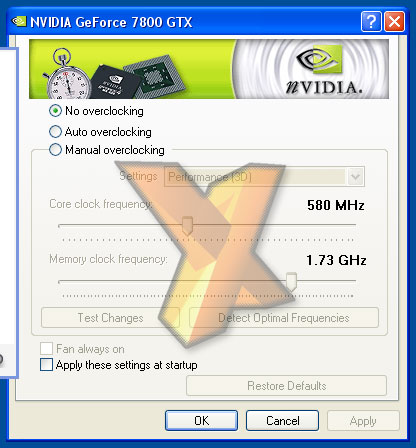XFX GeForce 7800 GTX 512MB DDR3 XXX Edition
The XFX XXX Edition comes in a box adorned by some kind of transsexual ninja dog that likes dressing up and doing its nails. Quite possibly the crappest box art I've ever seen, and that's saying something. It's a good job the large box contains goodness.
The board will look familiar if you've read HEXUS.core recently, the same dual-slot cooler adorning the reference board and a Leadtek 256MiB SKU, along with the Quadro FX 4500, in recent times. XFX do absolutely nothing with the cooler with the only thing to distinguish it from the reference hardware the sticker on the fan. You'd be forgiven for mistaking the two.
XFX's changes are all in the board's BIOS, setting higher clocks than NVIDIA do for the reference design. At 580MHz GPU clock (across all clock domains no less) and 865MHz memory clock, close to the 900MHz rating of the 1.1ns Samsung GDDR3 DRAM devices the board finds itself equipped with, that's 5.5% on the core and 1% on the memory.

A shot of the Coolbits overclocking property sheet in the driver control panel shows the confirmation of default, driver-agnostic, out-of-the-box clocks.
Noise
The comments we made for the reference board are true here. Allow us some shameless cut and paste action, please.The GTX 512's cooler is quiet and efficient (plenty of heat under load is moved out of the chassis, although a similar amount is pushed back in because of its design) and makes a very tolerable noise at all speed settings. Without a scientific measurement, I'll still venture the opinion that it's no louder than the original GTX.
Bundle Items
The hardware bundle for the XXX runs to a pair of S-Video cables for TV output, two DVI-to-VGA convertors, a component output cable and a Y-adaptor for creating the 6-pin power cable out of two regular 4-pin 'Molex' connectors, should your PSU lack the connector natively.
Software wise, XFX supply a copy of Tenomichi 3D Edit, a video editing package that uses the power of a DX9-class GPU to accelerate video rendering and apply real-time effects, using the shader hardware. You also get drivers to get you up and running, an overclocking utility should you wish to push things a bit further, and a trio of games titles. Far Cry, Moto GP 3 and X2: The Theat hardly set the gaming world on fire anymore, and XFX could do with updating this part of the bundle, but the games are decent enough and fine if you don't own any of them already, Far Cry especially. Crytek's first-person shooter, published by Ubisoft, is all kinds of awesome.













